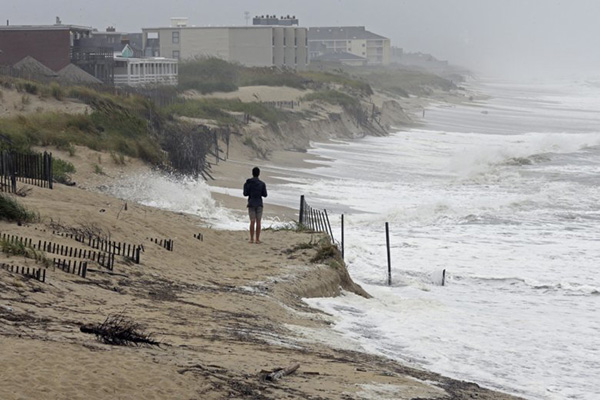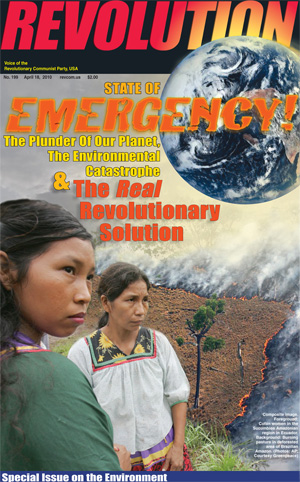Hurricane Florence Hits the Carolinas:
A Natural Occurrence—An Unnatural and UNNECESSARY Disaster
III. Outlawing Climate Science to Serve Profit-Driven, Environmentally Destructive Development
| Revolution Newspaper | revcom.us
Editors’ note, October 29. This fall, intense storms, including Hurricanes Florence, Michael, and Willa, and Typhoons Mangkhut, Jebi, and Yutu have battered countries in or along the Pacific and Atlantic oceans and caused at least 200 deaths.
Meanwhile, on October 8, two days before Hurricane Michael hit Florida, a new report by the United Nations’ leading body on climate science, the UN Intergovernmental Panel on Climate Change (IPCC), warned that the climate crisis is not a far-off problem—it’s happening right now, and it’s accelerating more quickly and having more devastating impacts much sooner than previously understood. The report called for radical, “unprecedented” transformations starting immediately to reduce greenhouse gas emissions from fossil fuels to prevent a global catastrophe. A co-chair of the group of 91 scientists from 40 different countries who wrote the report calls the next few years “probably the most important in our history.”1
In this five-part series on Hurricane Florence, we examine how the capitalist-imperialist system of today fuels such hurricanes and worsens the death and destruction, and start to grapple with why and how it would be radically different in a genuinely socialist society.
A 325-mile-long string of narrow sand islands—barrier islands—form North Carolina’s outer coast. These islands and their wetlands are breathtakingly beautiful, yet also extremely vulnerable to rising seas and devastating storms—as are many islands and coastal cities around the world, some home to millions of people.2
Hurricane Florence’s wind and storm surge hit North Carolina’s barrier islands on September 14, breaching sand dunes, inundating islands with sandy water, eroding, even washing away, some beaches, and dramatically changing the shape of North Carolina’s coast in some places.
People have a great need for recreation, natural beauty, leisure time—the question is how is that going to be done? Is it going to be driven by profit, in an environmentally devastating way that privileges access to those with the greatest means? Or is it going to be done in ways that preserve the natural environment and make it widely accessible to all?
Over decades, North Carolina has built up its precious, fragile barrier islands in ways that accelerate environmental degradation, make them more vulnerable to storms and put ever more people and animal and sea life in harm’s way.3
Why? Because it’s been enormously profitable to develop its coasts as a tourist destination, with homes, vacation homes and rentals, hotels and more.
North Carolina’s outer islands are facing some of the world’s highest rates of sea level rise. Yet their profitable development is so woven into the economic and social fabric of the Carolinas that North Carolina law forbids state and local agencies from using a 2012 North Carolina Coastal Resources Commission (CRC) report as a guide to coastal development. This report had warned that sea levels would rise by 39 inches—over three feet!—by 2100. (The National Oceanic and Atmospheric Administration projects the oceans will rise by more than six feet, enough to wash over some barrier islands at every high tide.4) The legislature insisted instead that decisions be guided by unscientific, outdated “business-friendly” estimates that vastly understated this danger. The Democratic governor could have blocked the bill, but did nothing.
This year, South Carolina did likewise. Its legislature “changed the preamble to a 30-year-old law governing beachfront development,” the New York Times reports, “striking out a state policy of ‘retreat’ from the shoreline in the face of erosion and replacing it with a policy of ‘preservation’ of the beaches.” In short, keep building.5
Federal government recovery policies, including the National Flood Insurance Program, are also shaped by capitalism and its short-term, profit-driven horizons. In the wake of these monster storms they are encouraging (paying) people to rebuild in place rather than relocate to more environmentally safe and more sustainable areas, in order to maintain housing prices, and profitable developments and tourist industries.6
An analysis in the Pacific Standard found that federal recovery funding along the Carolina coast overwhelmingly favored owners of high-priced properties situated right along the beaches (and therefore more environmentally damaging and vulnerable), that rebuilding projects undertaken by the Army Corps of Engineers were explicitly shaped by profit-in-command criteria, and that all this reinforced white supremacy:
A ProPublica analysis of 16 North Carolina communities directly behind beaches that have received federal funds shows they're 94 percent white on average; a quarter of owner-occupied housing in these areas is worth more than $500,000 (compared with 7 percent in North Carolina as a whole)....
The Corps, tasked with managing flood risk across America, takes on engineering projects like building levees and renourishing beaches ostensibly because they prevent property damage from future disasters and lock valuable beaches in place. The Corps prioritizes projects that would prevent the most amount of damage per dollar spent. This tends to favor beach building in high-income communities full of pricey properties. The Corps generally funds projects only when the expected benefit is 2.5 times as high as the project’s cost. Poor communities can’t meet that criteria....
Andrew Kahrl, a history professor at the University of Virginia, said he couldn't think of a single project that primarily benefited people of color. His research shows how the historically black communities that lived along the Carolinas’ coast were forced out by developers and federal infrastructure projects, including some built by the Corps.7
The same is true of efforts to restore and “protect” beaches and shorelines through beach “nourishment” (bringing in tons of sand to replace what has been swept to sea), building artificial dunes and reinforcing beaches with rock piles and sandbags. First, these “fixes” are temporary and they can actually accelerate further erosion. “These projects also cause substantial ecological damage,” Mat Gendle writes in Greensboro.com, “as they significantly alter habitats for sea life both in the underwater areas where the sand is dredged and on the beach where the sand is deposited.”8
Nonetheless, since 1939, federal, state, and local governments have spent over $828 million to restock beaches in North Carolina alone, renourishing the same beaches over and over. (One, Carolina Beach, has been renourished 31 times since 1955.)
One environment group calls it “flood, rebuild, repeat.” MIT professor of meteorology Kerry Emanuel calls these “unnatural disasters—disasters we cause by building structures” in places vulnerable to devastating storms. This is the kind of lunacy—from the standpoint of humanity and the planet—that capitalism-imperialism gives rise to and perpetuates, over and over and over.
A Revolutionary Approach to Recreation, Meeting Social Needs, and Being Caretakers of the Planet
As we’ve touched on in previous sections, revolutionary socialist society would no longer be imprisoned within the parameters dictated by the economic and social relations of capitalism-imperialism. How would this new society deal with the challenges posed in regard to North Carolina’s barrier islands?
One important dimension of this would be the way the new society would treat precious natural spaces:
Land, waters, forests, minerals, and other natural resources are protected and managed as “public goods.” They fall within the scope of public-state ownership. Socialist-state ownership recognizes its responsibility to preserve the “commons”—the atmosphere, oceans, wildlife, and so forth—for all of humanity and for the future.9
The new society would also be making it a priority to “provide for the recreation of the people, and to encourage their appreciation for nature and sense of awe and wonder at its many and diverse manifestations...”—and this means all sections of society, including especially those who’ve largely been denied these joys.
Another dimension would be that the new society would promote and train the masses of people, including the formerly oppressed, in a scientific approach to understanding and changing the world, including through the educational system. This would both enrich “recreational” time, but also better equip growing millions to contribute to dealing with natural disasters and the environmental devastation bequeathed by the current system. Science-denying, know-nothingism, relativism, and “it’s in God’s hands”-type thinking would no longer be promoted by society’s most powerful institutions!
But still there would be extremely difficult contradictions and problems to deal with. In relation to the barrier islands, for instance:
- Given rising sea levels (which revolution will not be able to immediately halt, and which will be with us for some time), what resources—if any—should be devoted to protecting or building on the islands? And how would this be done in an environmentally sustainable way?
- It is possible (as one house in Mexico Beach proved by surviving Hurricane Michael10), to build structures that survive even powerful storms. But should resources be devoted to that, and if so, what kinds of structures and facilities should be built?
- Places like the barrier islands would be opened up to the masses of people, both through state ownership and also by stressing public over private or individual development. However, many who were better off in the pre-revolutionary society would likely still own homes on the islands, and the new society would not take a revengist attitude towards them. In fact the Constitution for the New Socialist Republic in North America has specific provisions allowing some people (“who were not part of that ruling class and did not play an active role in opposing the revolution”) to keep some personal property, homes, and land for a period of time (provided it was not used as a means of production). So how would the new society handle the contradiction that some of these people would likely have the land best suited to public recreation? Although the CNSRNA authorizes the new state to acquire private land (with compensation) and convert it to public-state property, this contradiction would overwhelmingly be handled through public debate and discussion over how to best meet the needs of the new society – and the world – and persuading people, including the property owners, to put that first.11
- And the new society would be fighting for everyone to see these problems in a broader context, which would itself be controversial: our main goal should be protecting the coasts (and the environment overall) for future generations. In other words, being caretakers of the planet—not simply being guided by the needs and demands (however just) of those alive at the time. In his Greensboro.com opinion piece, Gendle, a professor at Elon University in North Carolina, argues that this means, in regard to the state’s barrier islands, that “we need to let the natural processes that govern island migration run their course. This almost certainly means abandoning properties to be overtaken by the sea and radically rethinking all future development of the ocean side of barrier islands.... If we want to preserve our islands, we must stop all artificial erosion interventions and let the islands move as they will.” Such a proposal would likely be vigorously debated, not only by those who may have homes on the island, but those who want to preserve historic Black communities, for instance, or others who want to open the islands up for people’s recreation more broadly.
In putting these contradictions before society and the masses of people, and fostering debate, discussion, and initiatives to address these issues, it would be important for communist revolutionaries to tap into and unleash the love millions of people have for the beauty of nature, their desire to save the environment, and their feeling that the outdoors, parks and so on should be shared by all.
1. See “United Nations’ Scientists Call for Drastic Action on Climate Change—The World Cries Out for Revolution,” revcom.us, October 15. [back]
2. The UN Intergovernmental Panel on Climate Change (IPCC) estimates that if temperatures rise 3.6° F (2° C), rising sea levels will flood coastal regions and Pacific islands. It is estimated that sea levels will increase 1.5 feet at these temperatures and that cities such as Miami and Shanghai will be largely submerged, along with a number of island nations around the world. [back]
3. The rapid increase in the numbers of people living on or near the coasts—many directly in the path of hurricanes and storms—is a global phenomenon which has continued even as the growing danger of rising seas and warming air and water has been scientifically established. For instance, in 2010, 123 million people in the U.S.—39 percent of the population—lived in counties directly on the coasts. This is a 40 percent rise since 1970. This, too, has been shaped in many different ways by the overall workings of capitalism-imperialism. [back]
4. “After Florence, barrier islands still doomed by rising sea,” Associated Press, September 13, 2018. [back]
5. “‘It’s Back’: Underwater Yet Again, the Carolinas Face a New Reality,” Jack Healy, Richard Fausset, and Campbell Robertson, New York Times, September 18, 2018. [back]
6. See “On the ‘Driving Force of Anarchy’ and the Dynamics of Change. A Sharp Debate and Urgent Polemic: The Struggle for a Radically Different World and the Struggle for a Scientific Approach to Reality,” by Raymond Lotta at revcom.us. [back]
7. “After Florence, North Carolina Must Rebuild Vulnerable Beaches Once Again,” Pacific Standard, September 27, 2018. [back]
8. “To preserve our beaches, North Carolina must rethink coastal real estate policies,” Mat Gendle, Greensboro.com, October 19, 2018. [back]
9. From “Some Key Principles of Socialist Sustainable Development,” revcom.us, April 18, 2010. [back]
10. “Among the Ruins of Mexico Beach Stands One House, Built ‘for the Big One,’” Patricia Mazzei, New York Times, October 14, 2018. [back]
11. From page 80 of the Constitution for the New Socialist Republic in North America. [back]

Hurricane Florence’s wind and storm surge hit Nags Head, North Carolina, September 14. Over decades, North Carolina has built up its precious, fragile barrier islands in ways that accelerate environment degradation and make them more vulnerable to storms. Why? Because it’s been enormously profitable. (Photo: AP/Gerry Broome)
"Not fit caretakers of the earth"
A clip from Revolution: Why It's Necessary, Why It's Possible, What It's All About, a film of a talk by Bob Avakian" given in 2003. Watch the whole talk at revolutiontalk.net.
CONSTITUTION For The New Socialist Republic In North America
(Draft Proposal)
Authored by Bob Avakian, and adopted by the Central Committee of the RCP
Get a free email subscription to revcom.us:

Volunteers Needed... for revcom.us and Revolution
If you like this article, subscribe, donate to and sustain Revolution newspaper.


